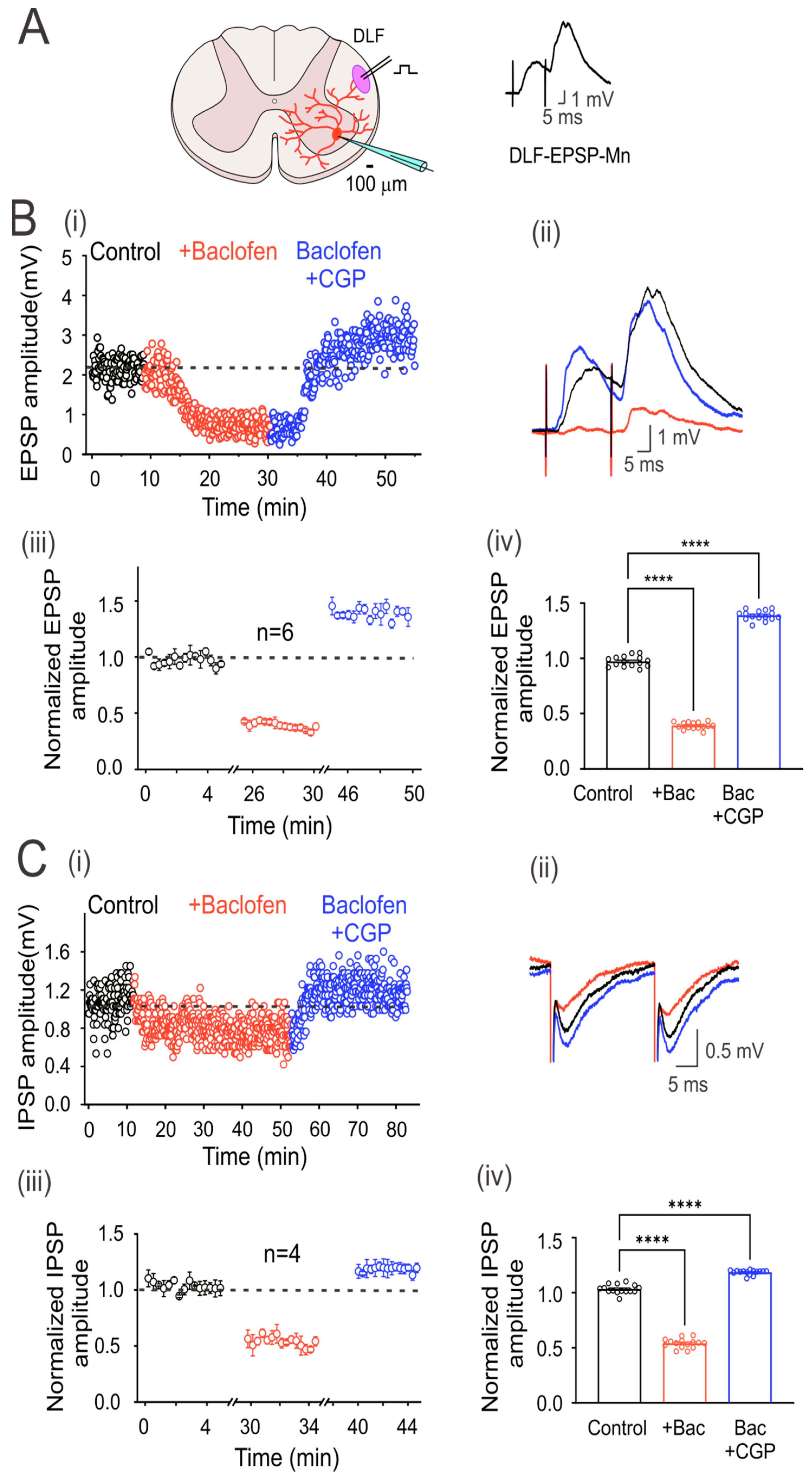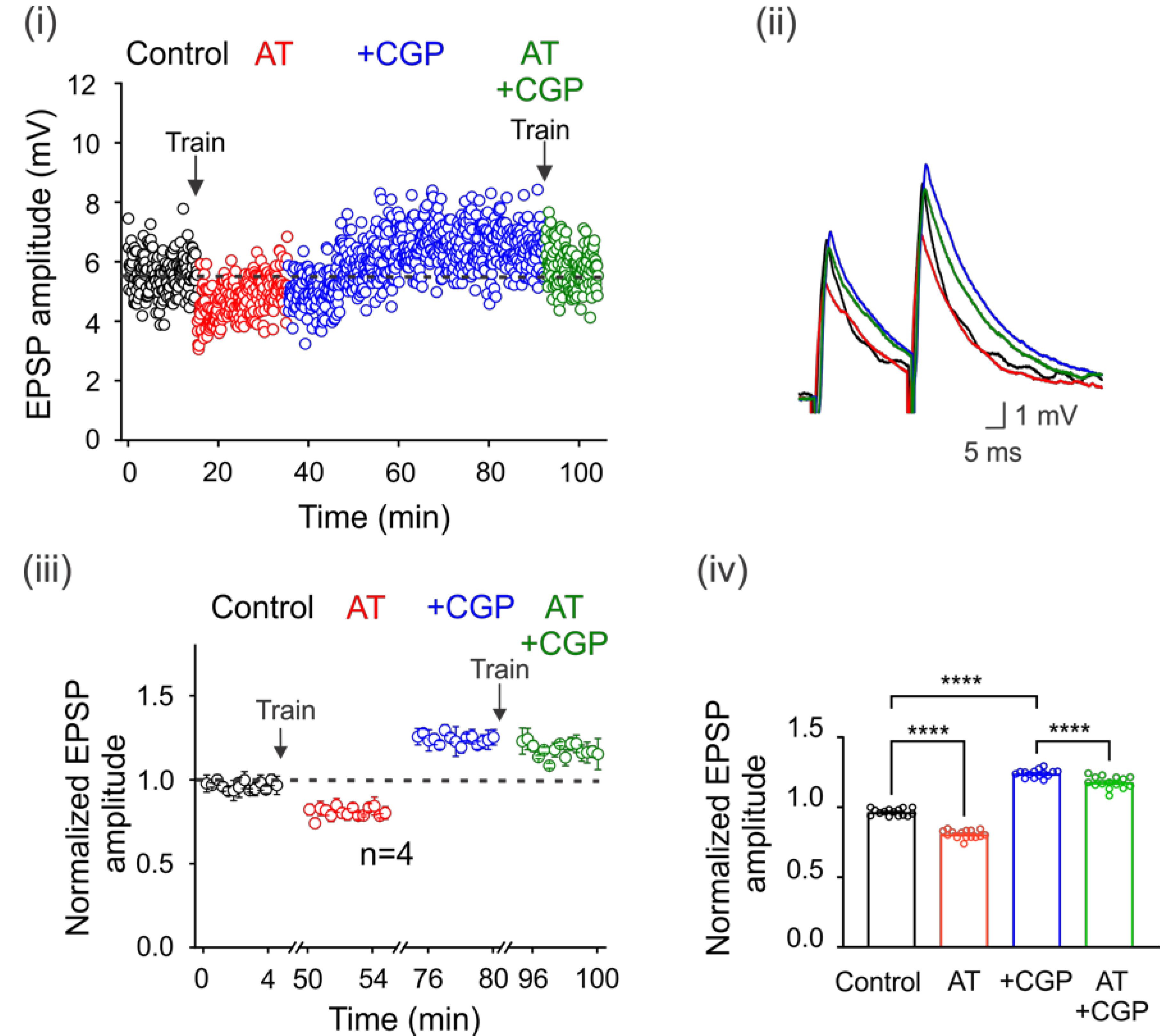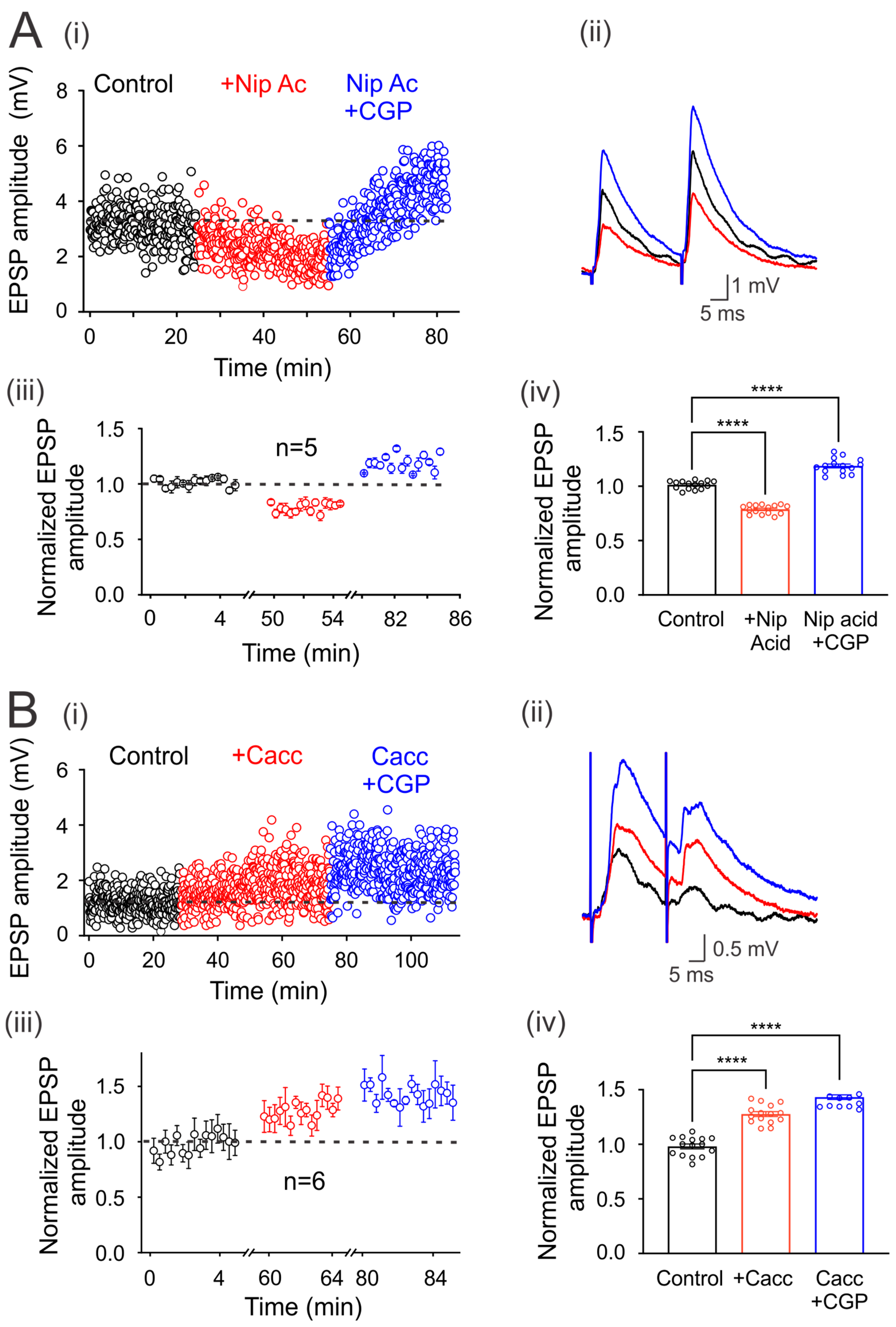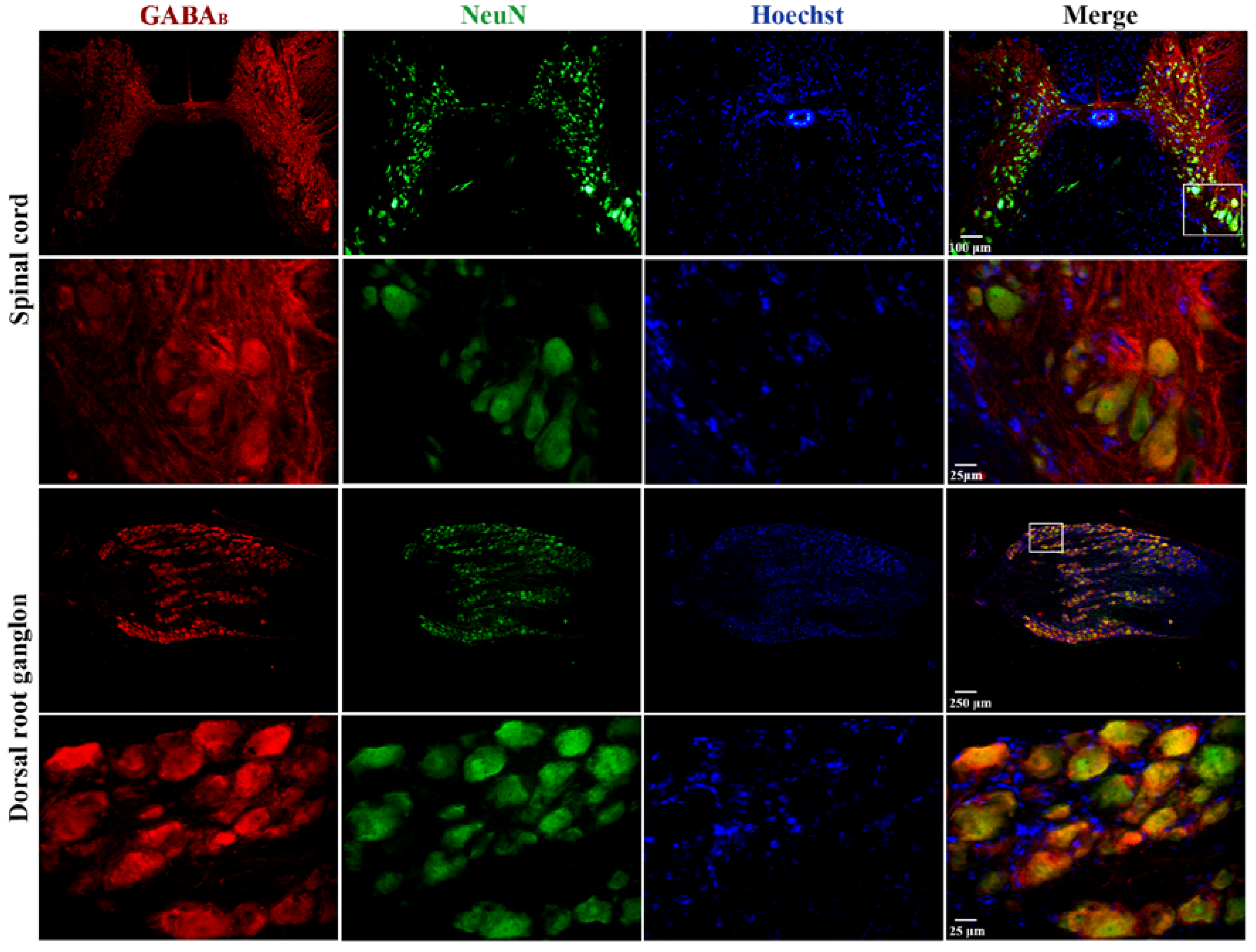GABAB Receptors Tonically Inhibit Motoneurons and Neurotransmitter Release from Descending and Primary Afferent Fibers
Abstract
:1. Introduction
2. Materials and Methods
2.1. Preparation
2.2. Spinal Cord and DRG Immunostaining
2.3. Intracellular Recordings
2.4. Drugs
2.5. Statistical Analysis
3. Results
3.1. Characterization of Motoneurons
3.2. GABAB Receptors Are Tonically Active in Ia Primary Afferent Fibers
3.3. GABAB Receptors Are Tonically Active in the DLF Terminals Synapsing Motoneurons
3.4. On the Origin of GABA
3.5. Regulation of Ambient GABA Concentration with GABA Transporters
3.6. GABA May Be Released through Best-1 Channels
3.7. GABAB Receptors Tonically Inhibit Motoneuron Excitability
3.8. GABAB Receptor Expression in the Spinal Cord and Dorsal Root Ganglia of the Turtle
4. Discussion
4.1. GABAB Receptors Tonically Inhibit Transmitter Release from DLF Terminals and Ia Afferents
4.2. The Cellular Origin of GABA
4.3. The Motoneuron Excitability Is Controlled Tonically by GABAB Receptors
4.4. GABAB Receptors and Spasticity
Supplementary Materials
Author Contributions
Funding
Institutional Review Board Statement
Informed Consent Statement
Data Availability Statement
Acknowledgments
Conflicts of Interest
References
- Jiménez, I.; Rudomin, P.; Enriquez, M. Differential Effects of (-)-Baclofen on Ia and Descending Monosynaptic EPSPs. Exp. Brain Res. 1991, 85, 103–113. [Google Scholar] [CrossRef]
- Kostyuk, P.G.; Vasilenko, D.A.; Lang, E. Propriospinal Pathways in the Dorsolateral Funiculus and Their Effects on Lumbosacral Motoneuronal Pools. Brain Res. 1971, 28, 233–249. [Google Scholar] [CrossRef] [PubMed]
- Curtis, D.R.; Malik, R. The Differential Effects of Baclofen on Segmental and Descending Excitation of Spinal Interneurones in the Cat. Exp. Brain Res. 1985, 58, 333–337. [Google Scholar] [CrossRef]
- Delgado-Lezama, R.; Aguilar, J.; Cueva-Rolón, R. Synaptic Strength between Motoneurons and Terminals of the Dorsolateral Funiculus Is Regulated by GABA Receptors in the Turtle Spinal Cord. J. Neurophysiol. 2004, 91, 40–47. [Google Scholar] [CrossRef] [PubMed]
- Curtis, D.R.; Lacey, G. Prolonged GABA(B) Receptor-Mediated Synaptic Inhibition in the Cat Spinal Cord: An in Vivo Study. Exp. Brain Res. 1998, 121, 319–333. [Google Scholar] [CrossRef]
- Edwards, F.R.; Harrison, P.J.; Jack, J.J.; Kullmann, D.M. Reduction by Baclofen of Monosynaptic EPSPs in Lumbosacral Motoneurones of the Anaesthetized Cat. J. Physiol. 1989, 416, 539–556. [Google Scholar] [CrossRef]
- Peshori, K.R.; Collins, W.F.; Mendell, L.M. EPSP Amplitude Modulation at the Rat Ia-Alpha Motoneuron Synapse: Effects of GABAB Receptor Agonists and Antagonists. J. Neurophysiol. 1998, 79, 181–189. [Google Scholar] [CrossRef] [PubMed]
- Sivilotti, L.; Nistri, A. GABA Receptor Mechanisms in the Central Nervous System. Prog. Neurobiol. 1991, 36, 35–92. [Google Scholar] [CrossRef] [PubMed]
- Eccles, J.C.; Schmidt, R.; Willis, W.D. Pharmacological Studies on Presynaptic Inhibition. J. Physiol. 1963, 168, 500–530. [Google Scholar] [CrossRef] [PubMed]
- Bautista, W.; Aguilar, J.; Loeza-Alcocer, J.E.; Delgado-Lezama, R. Pre- and Postsynaptic Modulation of Monosynaptic Reflex by GABAA Receptors on Turtle Spinal Cord. J. Physiol. 2010, 588 Pt 14, 2621–2631. [Google Scholar] [CrossRef]
- Yang, K.; Ma, H. Blockade of GABA(B) Receptors Facilitates Evoked Neurotransmitter Release at Spinal Dorsal Horn Synapse. Neuroscience 2011, 193, 411–420. [Google Scholar] [CrossRef]
- Salio, C.; Merighi, A.; Bardoni, R. GABAB Receptors-Mediated Tonic Inhibition of Glutamate Release from Aβ Fibers in Rat Laminae III/IV of the Spinal Cord Dorsal Horn. Mol. Pain 2017, 13. [Google Scholar] [CrossRef]
- Russo, R.E.; Nagy, F.; Hounsgaard, J. Inhibitory Control of Plateau Properties in Dorsal Horn Neurones in the Turtle Spinal Cord in Vitro. J. Physiol. 1998, 506 Pt 3, 795–808. [Google Scholar] [CrossRef] [PubMed]
- Svirskis, G.; Hounsgaard, J. Transmitter Regulation of Plateau Properties in Turtle Motoneurons. J. Neurophysiol. 1998, 79, 45–50. [Google Scholar] [CrossRef] [PubMed]
- Christensen, R.K.; Delgado-Lezama, R.; Russo, R.E.; Lind, B.L.; Alcocer, E.L.; Rath, M.F.; Fabbiani, G.; Schmitt, N.; Lauritzen, M.; Petersen, A.V.; et al. Spinal Dorsal Horn Astrocytes Release GABA in Response to Synaptic Activation. J. Physiol. 2018, 596, 4983–4994. [Google Scholar] [CrossRef] [PubMed]
- Lee, S.; Yoon, B.E.; Berglund, K.; Oh, S.J.; Park, H.; Shin, H.S.; Augustine, G.J.; Lee, C.J. Channel-Mediated Tonic GABA Release from Glia. Science 2010, 330, 790–796. [Google Scholar] [CrossRef] [PubMed]
- Ørsnes, G.B.; Sørensen, P.S.; Larsen, T.K.; Ravnborg, M. Effect of Baclofen on Gait in Spastic MS Patients. Acta Neurol. Scand. 2000, 101, 244–248. [Google Scholar] [CrossRef] [PubMed]
- Drummond, G.B. Reporting Ethical Matters in The Journal of Physiology: Standards and Advice. J. Physiol. 2009, 587, 713–719. [Google Scholar] [CrossRef]
- Moghaddasi, M.; Velumian, A.A.; Zhang, L.; Fehlings, M.G. An ex vivo preparation of mature mice spinal cord to study synaptic transmission on motoneurons. J. Neurosci. Methods 2007, 159, 1–7. [Google Scholar] [CrossRef]
- Hounsgaard, J.; Mintz, I. Calcium Conductance and Firing Properties of Spinal Motoneurones in the Turtle. J. Physiol. 1988, 398, 591–603. [Google Scholar] [CrossRef]
- Castro, A.; Aguilar, J.; Elias, D.; Felix, R.; Delgado-Lezama, R. G-Protein-Coupled GABAB Receptors Inhibit Ca2+ Channels and Modulate Transmitter Release in Descending Turtle Spinal Cord Terminal Synapsing Motoneurons. J. Comp. Neurol. 2007, 503, 642–654. [Google Scholar] [CrossRef] [PubMed]
- Glusman, S.; Vázquez, G.; Rudomín, P. Ultrastructural Observations in the Frog Spinal Cord in Relation to the Generation of Primary Afferent Depolarization. Neurosci. Lett. 1976, 2, 137–145. [Google Scholar] [CrossRef] [PubMed]
- Scanziani, M. GABA Spillover Activates Postsynaptic GABAB Receptors to Control Rhythmic Hippocampal Activity. Neuron 2000, 25, 673–681. [Google Scholar] [CrossRef]
- Kullmann, D.M. Spillover and Synaptic Cross Talk Mediated by Glutamate and GABA in the Mammalian Brain. Prog. Brain Res. 2000, 125, 339–351. [Google Scholar] [CrossRef] [PubMed]
- Curtis, D.R.; Game, C.J.A.; Lodge, D. The in Vivo Inactivation of GABA and Other Inhibitory Amino Acids in the Cat Nervous System. Exp. Brain Res. 1976, 25, 413–428. [Google Scholar] [CrossRef]
- Roepstorff, A.; Lambert, J.D.C. Factors Contributing to the Decay of the Stimulus-Evoked IPSC in Rat Hippocampal CA1 Neurons. J. Neurophysiol. 1994, 72, 2911–2926. [Google Scholar] [CrossRef]
- Semyanov, A.V. Diffusional Extrasynaptic Neurotransmission via Glutamate and GABA. Neurosci. Behav. Physiol. 2005, 35, 253–266. [Google Scholar] [CrossRef] [PubMed]
- Barakat, L.; Wang, D.; Bordey, A. Carrier-Mediated Uptake and Release of Taurine from Bergmann Glia in Rat Cerebellar Slices. J. Physiol. 2002, 541 Pt 3, 753. [Google Scholar] [CrossRef]
- Towers, S.; Princivalle, A.; Billinton, A.; Edmunds, M.; Bettler, B.; Urban, L.; Castro-Lopes, J.; Bowery, N.G. GABAB Receptor Protein and MRNA Distribution in Rat Spinal Cord and Dorsal Root Ganglia. Eur. J. Neurosci. 2000, 12, 3201–3210. [Google Scholar] [CrossRef]
- Désarmenien, M.; Feltz, P.; Occhipinti, G.; Santangelo, F.; Schlichter, R. Coexistence of GABAA and GABAB Receptors on A Delta and C Primary Afferents. Br. J. Pharmacol. 1984, 81, 327. [Google Scholar] [CrossRef]
- Andres, C.; Aguilar, J.; González-Ramírez, R.; Elias-Viñas, D.; Felix, R.; Delgado-Lezama, R. Extrasynaptic A6 Subunit-Containing GABAA Receptors Modulate Excitability in Turtle Spinal Motoneurons. PLoS ONE 2014, 9, e115378. [Google Scholar] [CrossRef]
- Lance, J.W. Spasticity: Disordered Motor Control. Symposium synopsis. In Symposia Specialists, Miami; Feldman, R.G., Young, R.R., Koella, W.W., Eds.; Medical Publishers: Chicago, IL, USA, 1980; pp. 485–500. [Google Scholar]
- Nielsen, J.B.; Crone, C.; Hultborn, H. The Spinal Pathophysiology of Spasticity—From a Basic Science Point of View. Acta Physiol. 2007, 189, 171–180. [Google Scholar] [CrossRef] [PubMed]






Disclaimer/Publisher’s Note: The statements, opinions and data contained in all publications are solely those of the individual author(s) and contributor(s) and not of MDPI and/or the editor(s). MDPI and/or the editor(s) disclaim responsibility for any injury to people or property resulting from any ideas, methods, instructions or products referred to in the content. |
© 2023 by the authors. Licensee MDPI, Basel, Switzerland. This article is an open access article distributed under the terms and conditions of the Creative Commons Attribution (CC BY) license (https://creativecommons.org/licenses/by/4.0/).
Share and Cite
Delgado-Ramírez, X.; Alvarado-Cervantes, N.S.; Jiménez-Barrios, N.; Raya-Tafolla, G.; Felix, R.; Martínez-Rojas, V.A.; Delgado-Lezama, R. GABAB Receptors Tonically Inhibit Motoneurons and Neurotransmitter Release from Descending and Primary Afferent Fibers. Life 2023, 13, 1776. https://doi.org/10.3390/life13081776
Delgado-Ramírez X, Alvarado-Cervantes NS, Jiménez-Barrios N, Raya-Tafolla G, Felix R, Martínez-Rojas VA, Delgado-Lezama R. GABAB Receptors Tonically Inhibit Motoneurons and Neurotransmitter Release from Descending and Primary Afferent Fibers. Life. 2023; 13(8):1776. https://doi.org/10.3390/life13081776
Chicago/Turabian StyleDelgado-Ramírez, Ximena, Nara S. Alvarado-Cervantes, Natalie Jiménez-Barrios, Guadalupe Raya-Tafolla, Ricardo Felix, Vladimir A. Martínez-Rojas, and Rodolfo Delgado-Lezama. 2023. "GABAB Receptors Tonically Inhibit Motoneurons and Neurotransmitter Release from Descending and Primary Afferent Fibers" Life 13, no. 8: 1776. https://doi.org/10.3390/life13081776




